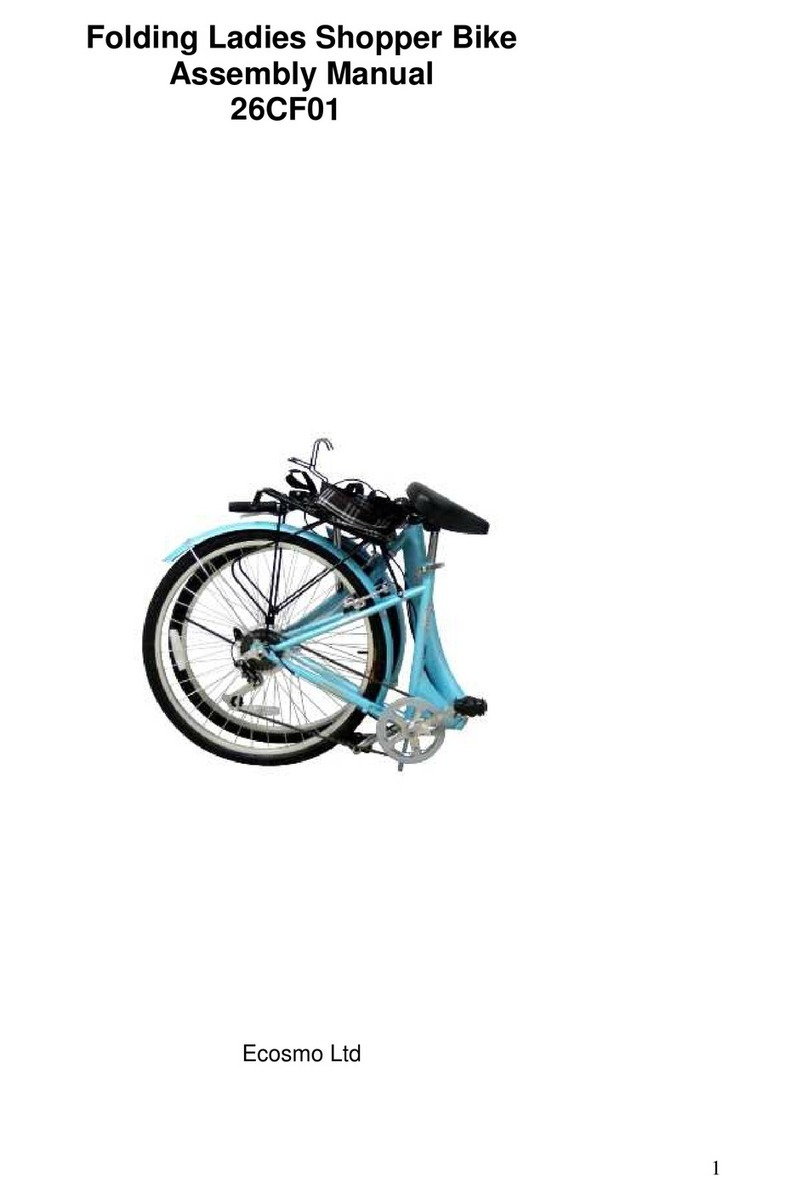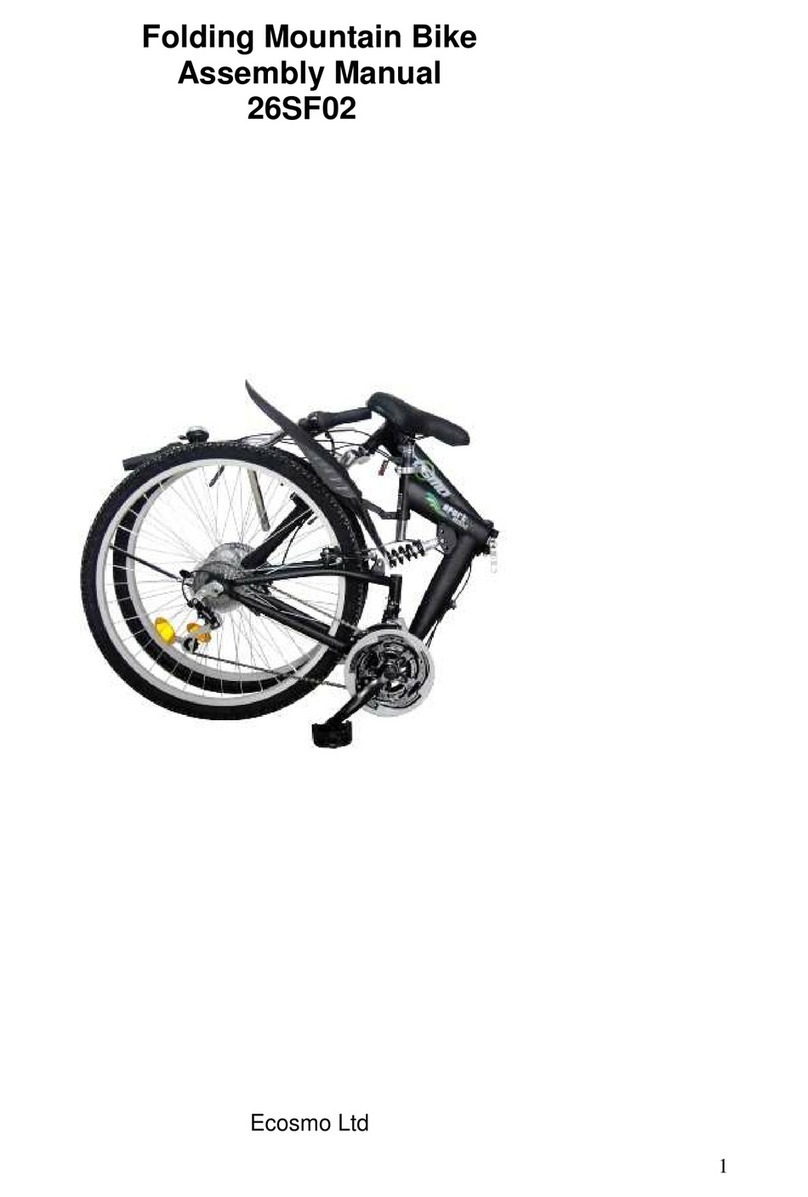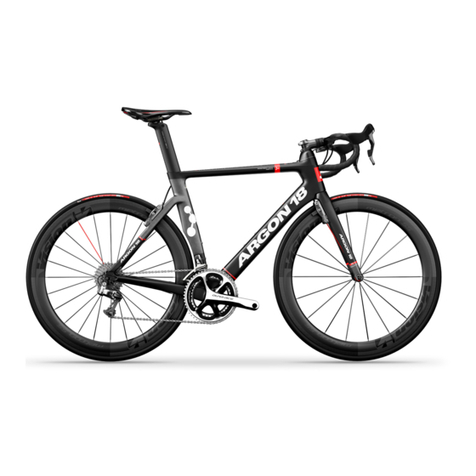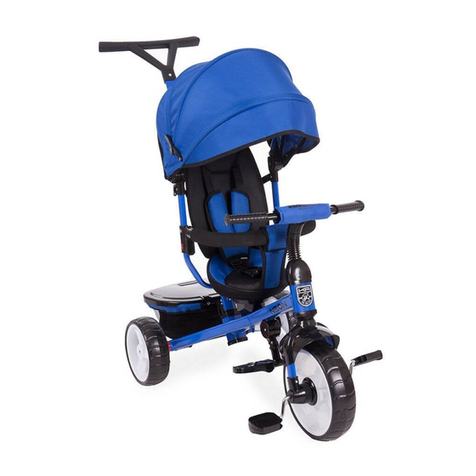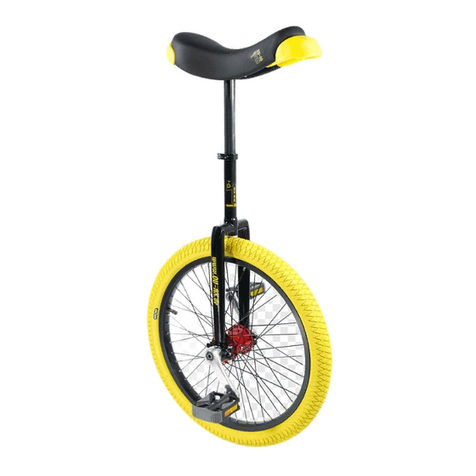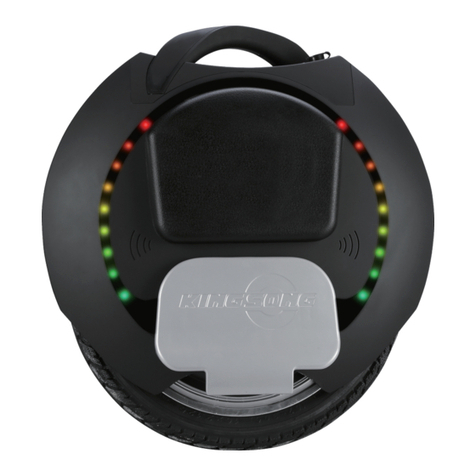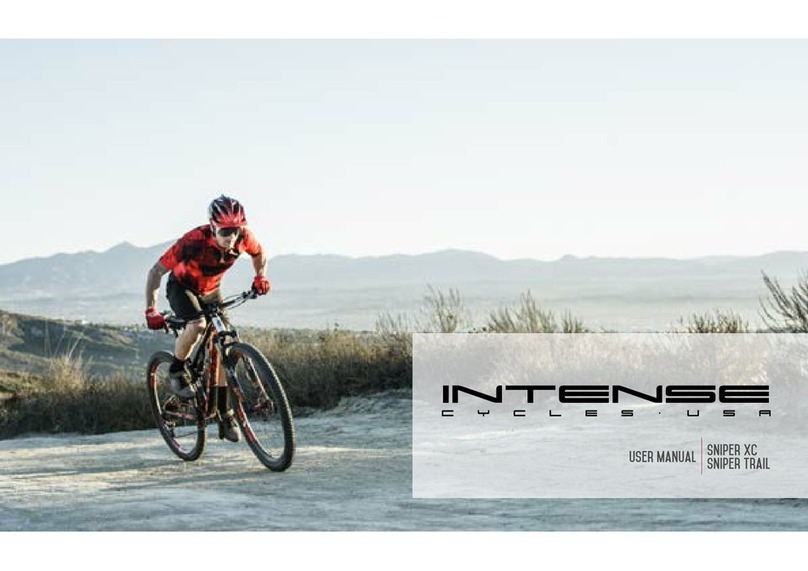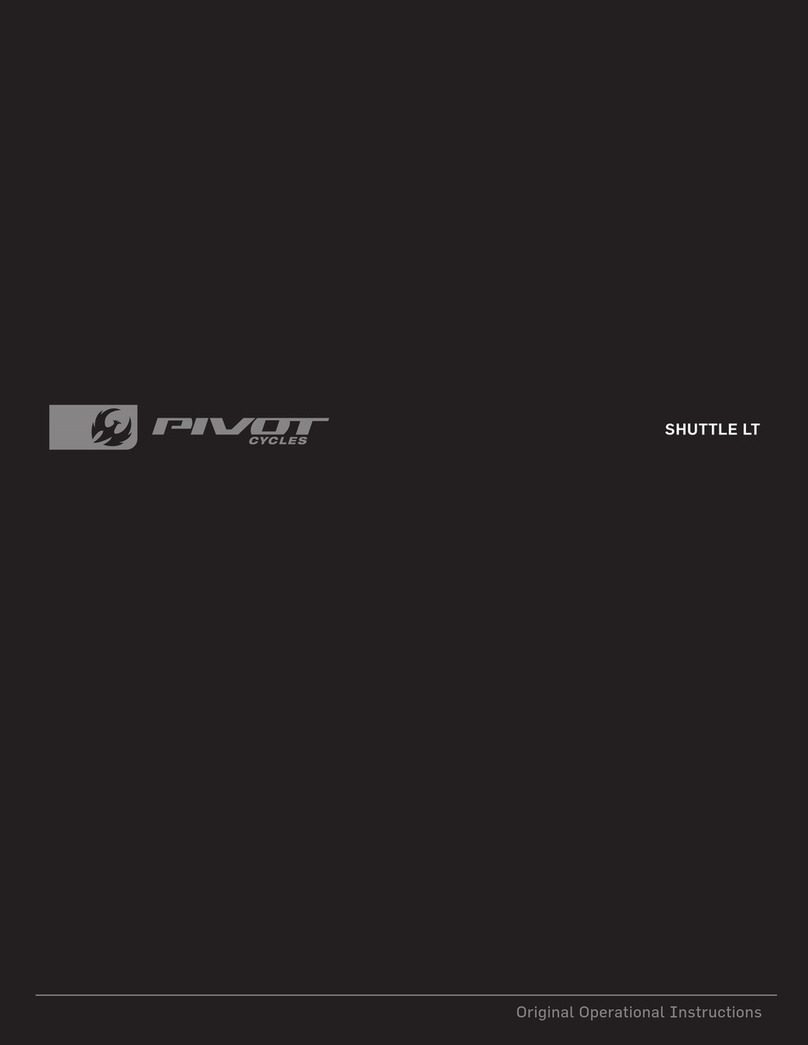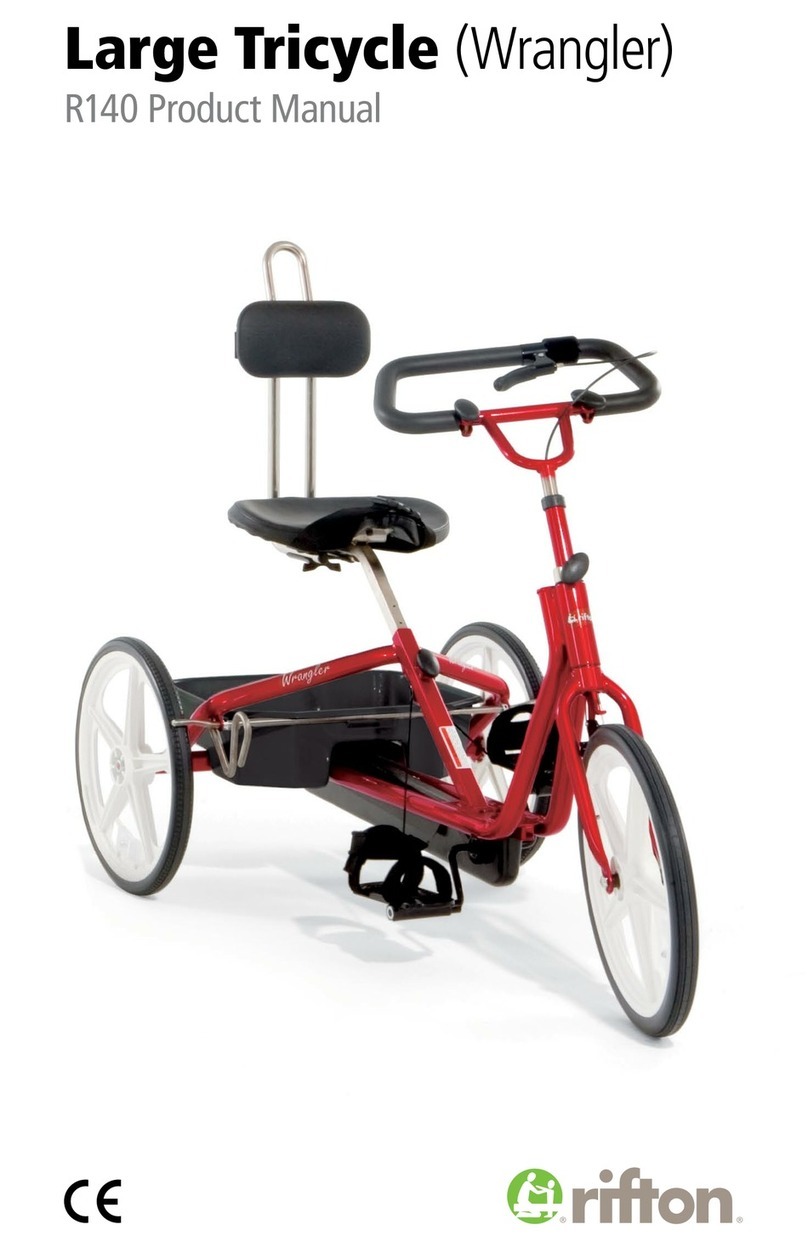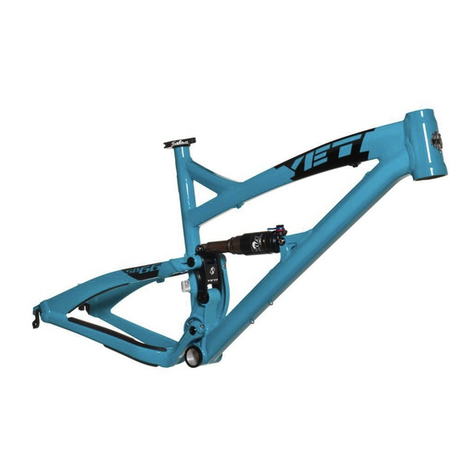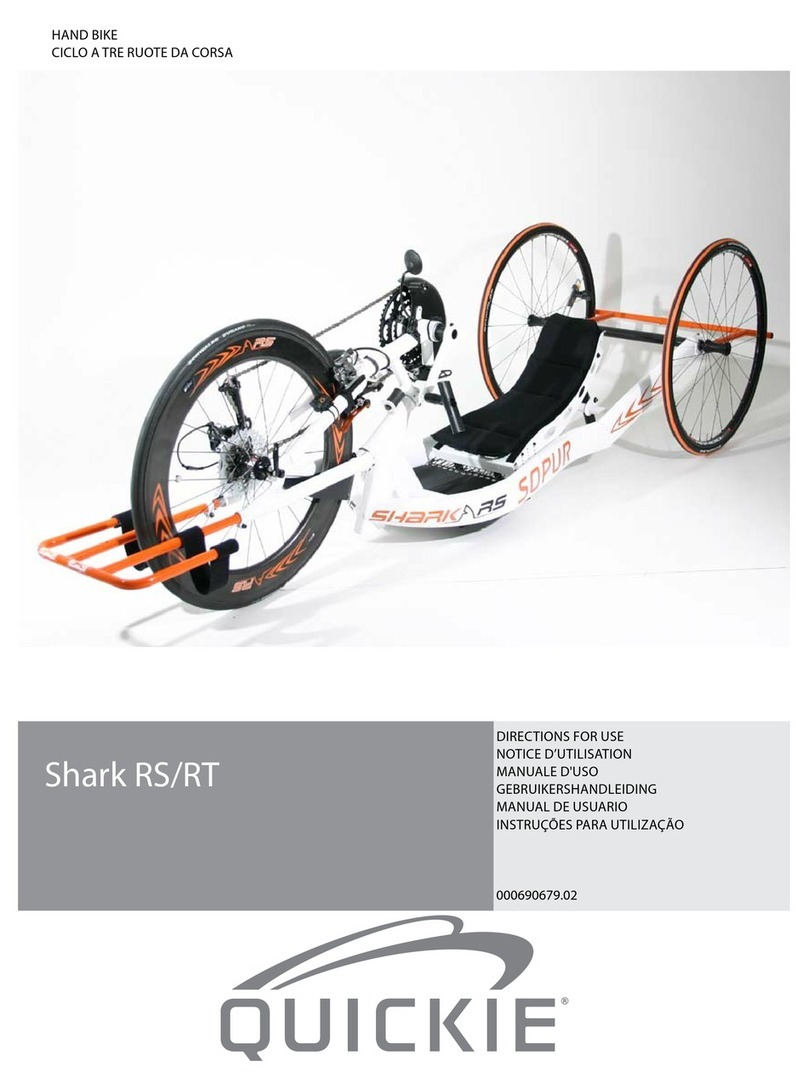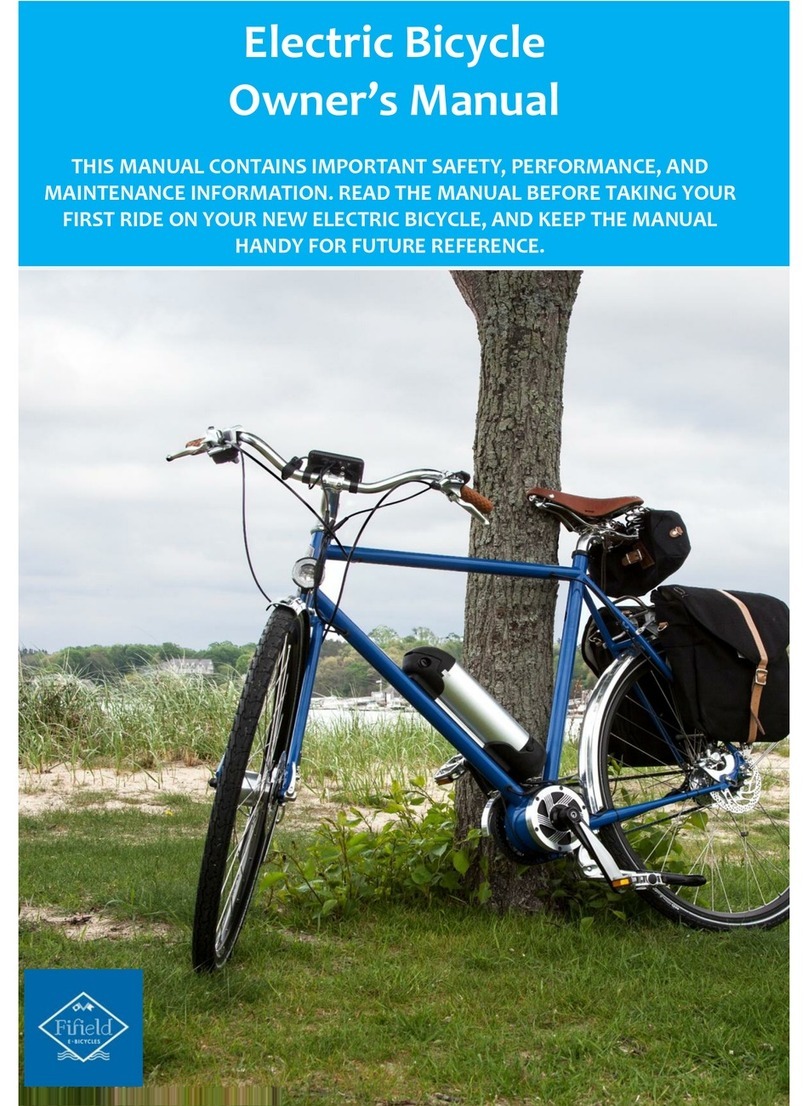Ecosmo Folding bicycle User manual

стр. 1
Folding bicycle instructin manual

CONGR ATUL ATIONS ON YOUR BIKE PURCHASE
Your bike is designed, assembled and adjusted for safe use meeting the highest
standards GB 3565-2005.
With proper care your bike will be making you happy over many years.
Due t erent models ar erently equipped, present manual provides
gener ormation.
Should you have any questions regarding our product or its parts please contact
your cycle dealer.
Assembly and initial adjustmen ools and require skills; therefore it
ected by an experienced seller’s mechanic.
Some maintenance can be performed only by a professional mechanic.
Since bicycle is a vehicle do not neglect safety rules.
Present manual contains useful information that will help you enjoy riding and use
your bicycle with no danger.
p. 2


p. 4
1. SAFETY
2. ASSEMBLY
3. ADJUSTMENT
3.1. Diagram of unfold the folding bike
3.2. Adjustment the height of stem and seat post
3.3. Handle bar
3.4. Saddle, seat post
3.5. Pedals
3.6. Front derailleur
3.7. Rear derailleur
3.8. Rim brakes
3.9. Mechanical disc brakes
3.10. Hydraulic disc brakes
3.11. Tyres
4. MAINTAIN YOUR BICYCLE
4.1. Before every ride
4.2. Once a week (about 100-200 km distance run)
4.3. Once a month (about 500-800 km distance run)
4.4. Once a season
5. GUIDE TO GENERAL RULES
5.1. Recommended tools for service and repair
5.2. Frame size choice
5.3. Seat (saddle) adjustment
5.4. Apparel
5.5. Gear shift
5.6. Chain
5.7. Storage
CONTENTS
_________________________________________________________
p. 6
p. 7
p. 8
p. 10
p. 12
p. 12
p. 12
p. 13
p. 14
p. 16
p. 17
p. 17
p. 18
p. 18
p. 19
p. 19
p. 19
p. 20
p. 20
p. 20
p. 20
p. 21
p. 21
p. 21

6. W ARR ANT Y INFORMA TION
6.1. Service life and warranty period
6.2. W arran ty terms
6.3. Buy er’s responsibilities
6.4. Cases not covered by warran ty
6.5. Remo ving bicycle from guar antee
7. D ATA SHEET
p. 22
p. 22
p. 23
p. 23
p. 23
p. 24
_________________________________________________________

p. 6
Present manual covers brand biycles.
1. SAFET Y
_________________________________________________________
1.1. ATTENTION! Please remember cycling can be a hazardous activity.
1.2. Before each ridecheck the bike as described in Section 4.
1.3. When riding
,use individual means of pr
otection.Wear a helmet to protect your
head from injury, glasses will cover your eyes from dust and insects, gloves will save
your hands in case of fall.
1.4.
Before entering r
oad traffic
,study its r
ules.Most countries and regions have their
own national regulations for cyclists. Here are the most crucial rules:
1.4.1. Use appropriate hand signals.
1.4.2. Ride along the required road side (never ride against tr
1.4.3. If you’re in a team while on the road cycle one by one.
1.4.4. Protect yourself (try to forecast unexpected). Remember: You are not always
visible; though cycling becomes more popular, many drivers do not know
bicycle signals.
1.5. B
e c
ar
eful when c
ycling on r
oads with danger
ous surface. P
lease be car
eful
while riding on gravel roads.
1.5.1. Make sure you’re allowed to ride there. Not all parks and private places are
opened for cyclists.
1.5.2. Put on protective apparel, including helmet, glasses and gloves.
1.5.3. Stubs, stones, potholes make ground cycling dangerous.
1.5.4. When going down slow down, moving your body backwards and down-
wards; it’s advisable to use rear brake.
1.5.5.
Avoid rocks, branches and hollows.
Consider others. Use the bell to warn them you’re on the way.
1.6. U
se br
ak
es with c
ar
e.Always keep a safe distance when stopping behind other ve-
hicles or objects. Braking distance and power should correspond to road conditions
depending on weather. Use both brakes at the same time and avoid front brake
overusing.
1.7.
Protect y
ourself.Always be ready to face risk. Please remember you are less visible
to other cyclists, bikers and pedestrians than a car. Always be prepared to stop or
skirt.

1.8. W at
ch the r
oad .Though road conditions and tracks design have recently become
better you should be always aware. You can meet pits, drains, low edges, etc on your
way. Cross the railway cautiously at the angle of 90 degrees. In case you don’t feel
ct ycle and drive it.
1.9. Wat
ch the par
ked c
ars when passing b
y.You can easily get into trouble in case
a car drives suddenly away or a car door is suddenly opened on your way. For your
safety it’s advisable to use the alarm bell.
1.10. B
e c
areful when driving a
t nigh
t time.Your bicycle is equipped with required re-
t e it’s necessary and make sure they are clean. Do remem-
ber no matter you have r tors you are still in danger of being injured unless light
is focused on them. We also advise you to set light equipment on your bicycle and
wear bright clothes to be seen on the road. The key point is to see and to be seen.
Please use numerous and various gadgets for that.
1.11. M
ind w
et w
eather.Any brakes no matter the design don’t function same way in
wet and dry weather. That is why one should stick to safety rules. When it’s wet out-
side your well adjusted and oiled brakes still require an increased lever pressure and
a longer braking distance. It will take you more time to stop. Besides, wet weather
leads to bad view (for you and car drivers) and worsens road adherence. Slow down
when turning on wet road. Greasy leaves and hatches can be dangerous as well.
1.12. If y
ou use additional equipmen
t and mak
e t
echnic
al changes t
o y
our bik
e(child
seat, additional seats, lighting equipment installed) take the national tr egula-
tions and applicable standards into account.
1.13. N ev
er lea
ve y
our bik
e unatt
ended t
o pr
even
t thef
t.
2. ASSEMBL Y
_________________________________________________________
2.1 Unf
old the f
olding fr
ame
2.1.1 All the folding bike should be folded
before go out
2.1.2 T t
ground,people stand out of the crank,
prepare to unfold the bike.
2.1.3 Before unfold the frame,make sure all the lock device are open.
2.1.4 Unfold the front and rear parts of the bike,make the folding device
closed,then the front and rear parts of the frame are on the same horizon.
2.1.5 6-8KGF. Press the folding device on the frame,make the device are closed,
it need 6-8KGF to close the folding device on the frame.

p. 8
2.2 Unfold the handle bar
2.2.1 Pull the handle bar opposite the folding direction,and let the folding
device full closed.
2.2.2 Press the folding button ,let the folding button be closed,it need
6-8KGF to close the folding button.
2.2.3 Turn the safe button anticlockwise,let the safe button fully cove the
folding handle.
2.3 Adjust the height of saddle
2.3.1 Seat post and handle stem all have the quick release device for adjust
the height.
2.3.2 Open the quick release ,and the can adjust the height of the seat post.
2.3.3 After adjust to the suitable height,press the handle of quick release,and
then close.
2.3.4 Adjust the quick release,one side of the quick release can be adjust,it is
consist of screw, turn the quick release clockwise or anticlockwise.
See also the section «3. ADJUSTMENT».
Your bicycle must be assembled by professional mechanics in an authorised
workshop or at the seller’s.
3. ADJUSTMENT
_______________________________________________________
3.1. Diagram of unfold the folding bike
3.11 Unfold the frame
6+,0$12

3.1.2 Unfold the handle bar
3.1.3 Unfold seat post
3.2 A
djustmen
t the heigh
t of st
em and sea
t p
ost
3.2.1 Handle stem
Insert the stem should not be less than the position of the safety line.
Close the quick release make sure it is safe.
stem
line
clamp
line
bolt of saddle
3.2.2 Saddle and Seat post
Seat post height can be adjust as you wish ,but the depth should not
be less than the position of safety line.
If have two safety line,can not be more than the highest safety line.
3.2.3 Angle of the saddle
Angle of the saddle should be slight up in order to avoid the rider leaned
forward.If have two safety line,can not be more than the highest safety
line.

chain
wheel spoke
nipple
rim
tyre
carrier
mudguard
cassette
rear derailleur
seat post clamp
chainwheel set with cranks
brake path
seat post
ekarbraer ekarbraer
saddle
p.10

brake cable
whe
el hub
fork
front brake
brake lever
shifter
stem
folding stem
quick release
folding device
of the frame
quick release
of folding
grip
Pedal

p. 12
3.2.
3.3. Handle bar
You can easily dene handlebar tilt and bent. Make sure the handlebar tilt is
horizontally centred in the stem. Otherwise, you may refer to your own comfort
requirements. To adjust/mount the handlebar release/take o Allen bolts, set the
bar within the stem centre and keep the necessary tilt direction. Torque the bolts in
rotation, in case it’s a two-bolt x; torque the bolts in chequer-wise rotation, in case
it’s a four-bolt x. The maximum torque is 5-8 N/m.
3.4. Saddle, seat post
Put the seat at the approximate height, the torque of quick-release bolt 5-8 N/m
(do not mount the seat post height drawn out beyond the limit). Get on your bike,
let somebody hold you or put the bike beside the wall when on it. Put your heels
on pedals. Spin the pedals back. When wearing your shoes there should be a slight
bend in your knee in a proper riding position. At the same time you shouldn’t fall
over the saddle when riding. Tip the saddle nose either parallel to the ground or a bit
up to stay on the seat without moving towards the handle bar. To adjust the saddle
angle and position towards the seat post back and forth release the bolt in the seat
post; in case you have a two-bolt x release the bolts in rotation. After you adjust the
saddle to the desired position torque the bolt with 12-15 N/m. In case of the two-
bolt x adjust the angle by tightening one of the bolts and loosening the other. The
nal torque for each bolt is 12 N/m.
left pedal right pedal
L R
pic. 8
3.5. Pedals
Before setting the pedals oil the thread
with grease thick coat, it will prevent
pedals sticking to cranks. When pedals
are mounted tighten their axles inside
the cranks with torque of 20-30 N/m
(pic. 8, 9).
crank
key
pedal pedal
key
pic. 9

3.6. Fron t derailleur
3.6.1. Mount the front derailleur on the seat tube so that the guide plate of
the derailleur is in parallel with the chainwheels and distance from plate
outside till bigger chainwheel is 2-4 mm (pic. 10, 11). T orque
is 5-8 N/m.
3.6.2. Set the chain onto the smallest front chainring and the largest rear sprocket
(pic. 12).
3.6.3. Using the stop screw L (low) adjust the front derailleur innermost position
so that chain is 1-2 mm apart from the plate inner side (pic. 12).
3.6.4. Set the left shifter to the small chainwheel position and increase the front
derailleur cable tension so that it couldn’t lengthen (5 N/m) (pic. 13). Pay
attention to check whether derailleur cable is duly grooved where cable is
ed.
3.6.5. Turn the cranks forward and set the chain to the biggest front chainring and
the smallest rear sprocket (pic. 15).
3.6.6. Using the stop screw for shifter make the front derailleur duly function (pic.
14).
3.6.7. Using the stop screw H (high) adjust the front derailleur outermost position
so that the guide plate couldn’t move crankward, at the same time chain
should easily shift on to the largest chainring.
front derailleur guide plate
front derailleur
sprockets
pic. 10
front derailleur guide plate
2-4 mm
biggest chainwheel
pic. 11

p. 14
3.7. Rear derailleur
3.7.1. Before adjusting rear derailleur make sure its fastener is not deformed and
the guide plate is in parallel with the chainwheels (pic. 16).
3.7.2. Turn the cranks forward and mount the right shifter to the small chainwheel
position; set the chain onto the smallest rear sprocket (pic. 18).
3.7.3. Turn the adjustment bolt counterclockwise in half turns until the cable is
tensioned (pic. 17).
cable
adjusting screw
front derailleur guide plate
biggest rear chainring smallest front chainring
stop screw L (low)
1-2 mm
chain
sprocket front chainwheels
1-2 mm
adjusting screw
left shifter
front deraileur guide plate
biggest front chainringsmallest rear chainring
sprocket front chainwheels
stop screw H (high)
chain
1-2 mm
derailleur hanger
rear view
rightwrong wrong
plate with roller
pulleys
sprockets
pic. 12
pic. 15
pic. 16
pic. 13
pic. 14

3.7.4. Using the stop screw H (high) adjust the rear derailleur outermost position
so that derailleur roller is situated exactly under the smallest sprocket (pic.
18).
3.7.5. Fix the rear derailleur cable tension so that it couldn’t lengthen (5 N/m) (pic.
19).
3.7.6. Turn the cranks forward and set the chain to the largest sprocket (pic. 20).
3.7.7. Using the stop screw L (low) make sure when gear is the lowest (the larg-
est sprocket) the plate with rollers freely functions in-plane of bigger chain-
wheel (pic. 20); at the same time shifter should be easily and exactly set to
the lowest gear.
3.7.8. Using the stop screw for shifter (or derailleur) delicate adjustment make the
rear derailleur duly function (pic. 17).
rear view
plate with roller pulleys
stop screw H (high)
smallest rear sprocket
sprockets
derailleur hanger
right shifter
rear derailleur
cable tension
adjusting screw
rear view
stop screw L (low)
biggest sprocket
plate with roller pulleys
cable
fixing bolt
pic. 17
pic. 19
pic. 18
pic. 20

p. 16
3.8. Rim brakes
3.8.1. Mount the brake pads so that the pad braking surface is in parallel with the
rim braking surface and it’s set right in the middle (pic. 21).
3.8.2. Tighten the adjusting bolt against the brake lever and unscrew it by two
turns (pic. 22), x the cable on the lever in such a way that distance between
pads and rim amounts to 1-2 mm (5 N/m) (pic. 23).
3.8.3. Pull the brake lever, use the lock ring if necessary to adjust the distance
between brake pads and rim (pic. 22).
3.8.4. Use the adjusting bolt on brake arms to pull them equally aside (pic. 24).
3.8.5. Once pads become worn and cables are pulled adjust the cable tension by
using the lever bolt or by using the lock nut at the cable holder located at
the point where the brake cable enters the brake lever; please, keep in mind
the lock should be screwed 5 mm less into the lever.
end-view top view front view
wheel rim
brake pad
wheel rim wheel rim
brake pad brake pad
wrong
wrong
right right right
wrong
adjusting screw
brake arm
cable
1-2 mm
fixing bolt
brake arm
brake pad
wheel rim
adjusting screw
brake lever
pic. 21
pic. 22
pic. 23
pic. 24

3.9. M echanical disc brakes
3.9.1. Before adjusting disc brakes make sure discs are not deformed, pads’surface
is smooth, without any scratches.
3.9.2. With your eye control set the disc brake caliper in such a way that pad
braking surface is in parallel with the brake disc. Fix the caliper bolts (5-8
N/m) (pic. 25).
3.9.3. Use the adjusting bolt to moun ed pad in such a way it is as close as
possible to the disc without touching it while wheel rotating.
3.9.4. Adjust the brake cable so that when pulling the lever it’s 2-3 cm apart from
the handlebar (5-8 N/m) (pic. 26), if required use the adjusting bolt on the
brake lever.
3.9.5. As a rule disc brakes completely grind after 100-200 km distance run.
3.9.6. In proportion to wear use the adjusting bolt on caliper and brake lever to
set necessary clearance between pads.
floating brake pad
fixed brake pad
brake disk
brake caliper
fixed brake pad
adjusting screw
brake disk
fixing bolt
cable
brake caliper
adjusting screw
brake lever
pic. 26
pic. 25
3.10. Hy draulic disc brakes
3.10.1. Before adjusting hydraulic disc brakes make sure discs are not deformed,
pads’surface is smooth, without any scratches.
3.10.2. With your eye control set the disc brake caliper in such a way that pad
braking surface is in parallel with the brake disc (pic. 27). Fix the caliper
bolts (5-8 N/m).
3.10.3. Use the adjusting bolt to mount the brake lever at your own requirement
(pic. 28).
3.10.4. As a rule disc brakes completely grind after 100-200 km distance run.

p. 18
3.11. Tyres
3.11.1. Before riding pump up the wheels till the required pressure. The pressure
needed is shown on the tyre sidewall.
3.11.2. Use the pump appropriate for your bicycle nipple. There are two main types
of nipples: for bicycle (PRESTA) and car (SCHRADER) (pic. 29, 30).
3.11.3. Before you start inating a bicycle tyre with PRESTA nipple, loosen the safety
screw (pic. 30), make sure it works after one-time press. Once you inate the
bicycle tyre with PRESTA nipple, tighten the safety screw back.
car nipple
(schrader)
bicycle nipple
(presta)
open closed
safety screw
bicycle nipple
(presta)
pic. 29 pic. 30
brake support
brake pads
brake disc
oil path
brake lever
adjusting screw
pic. 27 pic. 28
4. MAINTAIN YOUR BICYCLE.
_________________________________________________________
4.1. Before every ride
4.1.1. Check the way your brakes function. Press the brake lever rolling the bicycle
forward and backward. The wheels should clearly block.
4.1.2. Check the holding force of wheels quick releases.
4.1.3. Check the tyre pressure (Tips are given in 3.11).

4.2. O nce a week (about 100-200 km distance run)
4.2.1. Clean and oil the chain (choose special silicone or t icants,
epending on weather conditions and riding
frequency the break between maintenance sessions can vary.
4.3. O nce a month (about 500-800 km distance run)
4.3.1. Check the chain for wear using the tool required.
4.3.2. Check whether hub, headset, bottom bracket and pedal bearings are
properly adjusted.
4.3.3. Tight the crank bolts to the tor tion. For cranks set to bottom
bracket axle — 35-40 N/m.
4.3.4. Check that all stem and handle bar bolts are tightened to the torque
tion (5-8 N/m).
4.3.5. Check the wheels radial and face true. If necessary change the rims. To
adjust you will need a spoke wrench (we strongly advise you to contact an
authorised service centre in this case).
4.3.6. Check brake pads condition, in case you have V type brakes; check the wear
of rims braking surface. Once the special grooving remains the rim is still
possible to use; once the grooving is no longer visible, the rims are subjext
to change.
4.4. O nce a season
4.4.1. Suspension fork is maintained according to the manual enclosed. Fork oil
seals are to be cleaned or replaced o be changed. If you
ride your bicycle when it’s rainy, snowy or dirty service it more often than
the schedule suggests. You can determine by sight or once you feel the fork
malfunctions whether suspension systems require service.
4.4.2. Check cables and their cover condition. The cover should not be damaged
in the cable-held places.The cables must have smooth surface with no signs
of souring and be able to run freely inside the cover. If required, change the
cables and cover.
4.4.3 Change the lubricant inside the hubs, bottom bracket and head set (pro-
vided that bearings are possible to dismount for service).
Weeks of bicycle riding (about 100 km distance run) take it to the
service centre f tenance. It includes determining torque of cranks on
bottom bracket spindle (500 Nm); checking headset, stem and handle bar torque
(star nut — 3 Nm, stem bolts — 5 Nm); spokes’tension check; brakes and derailleurs
adjusting. Bicy tenance in authorised service centre will be free if it’s
bought from your dealer.

p. 20
5. GUIDE TO GENERAL RULES
_________________________________________________________
5.1. Recommended tools for service and repair:
• Torque wrenches with measure range of 3 to 50 N/m;
• Allen keys 2, 3, 4, 5, 6, 8 mm;
• Spanner keys 9, 10, 13, 15, 17 mm;
• Cap keys 15 mm;
• Screwdriver Ph+ (1);
• Tire levers;
• Air-gauge pump.
For further consult on wide range tools usage please contact your dealer.
5.2.
5.3.
Seat (saddle) adjustment
Follow the recommendations given in 3.4. Your comfort cycling will depend on cor-
rectly chosen saddle height and shape, as well as its adjustment.
5.4.
Apparel
We strongly advise you to wear a helmet. Choose the one considering your riding
style and frequency. Let a bike shop assistant help you when buying. Cycling gloves
will let you provide a good grip for the bar. Sole of the shoes should be sti and non-
slip. Clothes should be loose and comfortable tting your body. Wide pant legs can
easily be caught by cranks or stuck between the chain and chainwheel. Wide jacket
or T-shirt can easily hitch on the bar, stem or seat.
Gear shift
While riding choose the most comfortable for you sprockets ratio regards the area.
Follow the rule to never use such derailleur gears as: smallest front chainwheel –
smallest rear sprocket, largest front chainwheel – biggest rear sprocket. Such use
leads to the unfavorable run of chain and fastens chain and sprockets wear.
Pressing the shifter moves the chain to the large chain rings. When shifting the
chain over the chain wheels (front derailleur) it’s advasable to apply less force with
pedals, at least before the chain reaches the 6-7 teeth sprocket. Otherwise, such shift
can lead to chainwheel break down (bend, teeth damage) or chain out of order (links
torn or bent).
When shifting the smallest rear sprockets (rear derailleur) it’s advisable to slow down
the pedal force. Do not try to shift the gears without chain rotation. It may disadjust
the derailleurs.
Table of contents
Other Ecosmo Bicycle manuals
